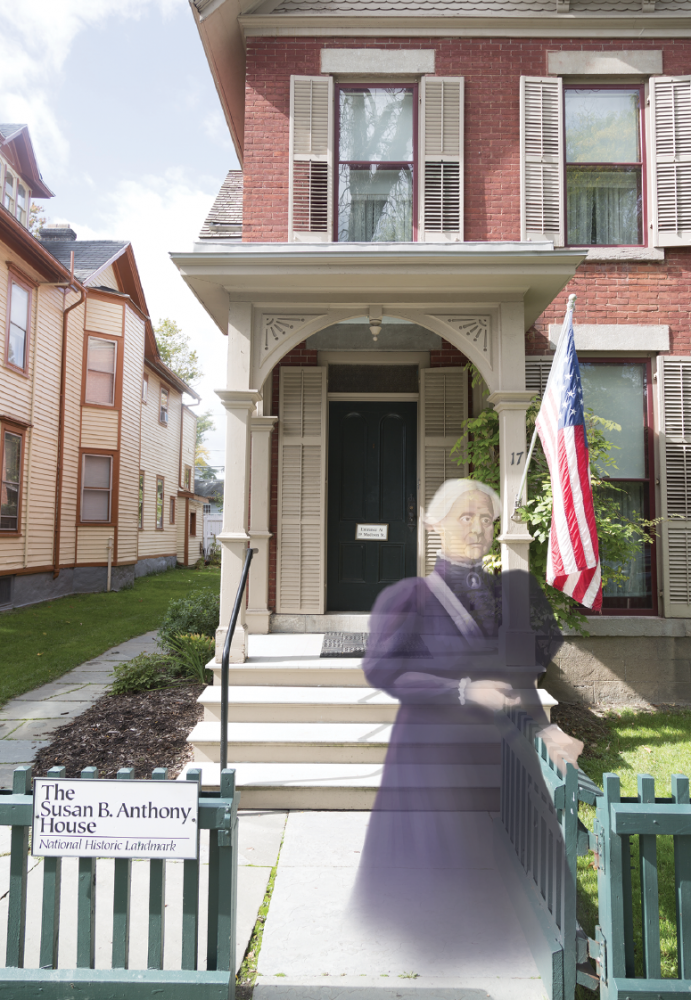2017 marks the historic 100th anniversary for New York State women winning universal suffrage. The 19th amendment’s ratification was still three years away, and no other state east of the Mississippi had at that point passed such a referendum. Although it was a precursor for what was to come, the moment was the culmination of nearly 70 years in the making.
Forming a Movement
The state was home to activists like Elizabeth Cady Stanton, Antoinette Brown Blackwell and Susan B. Anthony, just to name a few. However, many of them got their start campaigning for other causes besides women's suffrage.. Anthony, for example, started off as an activist for temperance and abolition.
Tina Lent, the director of Museum Studies at RIT, noted that taking part in movements like those gave leaders like Anthony an idea of how to shape all the disparate grievances and ideas of betterment into an actual program for women’s rights.
“The world was changing and the people who used to be in power find themselves slipping out of power."
“They were women who had gone to London to an international abolition conference and were told, because they were women, they couldn’t speak in public,” Lent explained. “So they had become aware of the limitations of their power due to the mere fact of being women.”
According to Lent, the Women’s Right’s movement began in earnest after the Civil War. Yet, after the 15th amendment included race but not gender, Anthony and Stanton splintered from the abolition movement w
“They felt that if we tried to do two things at once with the 15th amendment we’d lose everything,” Lent said. “What that ended up doing is splitting the women’s rights movement from the abolition movement; half of the women’s movement decided that they would stick with abolition, because that’s where they started from — they would do one thing at a time.”
It was not until 1890 that both movements came together again to form one organization, the National American Women’s Suffrage Association, which was key in deciding the strategies used in the next 20 years.
During the 1910s and the decades leading up to victories such as New York's referendum, the worst sort of reactionary responses to women's suffrage manifested.
“Editorial cartoons, for example, showed men wearing aprons and men taking care of babies,” Carroll said. “The implication was if women have the right to vote then they’re going to shirk their responsibilities and their jobs as mothers and it’s going to upset the gender balance.”
Like many calls for social change, the women’s suffrage movement was met with a pervasive toxicity stemming from a fear of being replaced.
Lasting Impact
For Lent, the outcome of the November 2016 election and ensuing events like the 2017 Women’s March re-contextualized several aspects of the Centennial celebration.
While working on an exhibit for the Rochester Public Library titled "Because of Women Like Her" these past few months, Lent and her colleague Dr. Juilee Decker were constantly reminded of the women's rights movement's lasting impact.
“The purpose of that exhibit ... is to frame the centennial in light of Rochester,” Decker explained. “And to have people in Rochester, the region and visitors from all over really come to understand the women’s suffrage movement and the broader women’s rights [movement] through the lens of Rochester.”
Lent recalled that the project began in the first two months of 2016. At the time, while it wasn’t explicit, they began almost assuming this celebration of women’s suffrage would occur during the administration of our nation's first female president.
“Part of the exhibit, rather than being more celebratory, ended up being more cautionary.”
“The original idea [was] that we would take it up to 1920, but with the events of last year two more cases were added,” Lent said, referring to the "I Voted" stickers left at Susan B. Anthony’s grave in Rochester and the Women’s March. “Part of the exhibit, rather than being more celebratory, ended up being more cautionary.”
In addition to being a direct cautionary tale, the movement that led up to New York passing universal suffrage in 1917 provides several valuable lessons about pushing for societal change. Both Carroll and Lent stressed that the successes and failings of the suffrage movement embody the need to build a diverse and inclusive coalition.
“There were times when they were not inclusive, where they were racially exclusive,” Carroll said about compromises made in the 1890s to appeal to southern white women. “That hinders groups of women coming together now, because they hear about that history and they’re turned off by it — rightly so.” It's a lesson that seems just as relevant today while avoiding the pitfalls of the likes of white feminism, for instance.
What’s transpired in recent months has been a reminder to Lent that there’s always going to be more work to do. Similarly, both Decker and Carroll expressed that the story of the women’s suffrage movement carries extra weight in 2017, as it encapsulates how sought-after, fought-for and valued civic representation was.
Decker emphasized that individuals, including students, need be aware of the agency they have.








